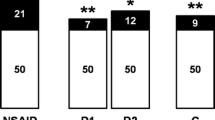Abstract
Forty-nine patients with ureteral colic were included in this prospective double-blind study investigating the analgesic efficacy and side effects of a prostaglandin synthetase inhibitor Diclofenac sodium (Voltaren®) versus a spasmolytic drug Tropenzilium bromide (Palerol®). The analgesic efficacy and side effects of the calcium antagonist Nifedipine (Nidilat®) applied sublingually in ureteral colic were also investigated.
It was concluded that diclofenac sodium was more efficient for relieving pain due to acute ureteral obstruction and had fewer side effects than spasmolytic drugs. Nifedipine proved to have an analgesic effect equivalent to that of Tropenziilium bromide.
Similar content being viewed by others
References
Nishikawa, N., Morrison, A., Needleman, P.: Exaggerated prostaglandin biosynthesis and its influence on renal resistance in the isolated hydronephrotic rabbit kidney.J. Clin. Invest., 59, 1143 (1977).
Allen, J. T., Vaughan, E. D., Gillenwater, J. Y.: The effect of indomethacin on renal blood flow and ureteral pressure in unilateral ureteral obstruction in awake dogs.Invest. Urol., 15, 324 (1978).
Al-Ugaily, L., Thulesius, O., Angelo-Khattar, M.: New evidence for prostaglandin induced motility of the ureter.Scand. J. Urol. Nephrol., 20, 225 (1986).
Kantor, T. G.: Use of Diclofenac in analgesia.Am. J. Med., 80, 64 (1986).
Carol, W.: Nifedipine and ureteral colic.Ann. Int. Med., 102, 864 (1985).
Bortolotti, M., Trisolino, G., Barbara, L.: Nifedipine in biliary and renal colic.JAMA, 258, 3516 (1987).
Viskin, S., Kaver, I., Greenstein, A., Hassner, A.: Nifedipine and ureteral colic.Ann. Int. Med., 105, 142 (1986).
Lundstam, S. O. A., Leissner, K. H., Waohlander, L. A., Kral, J. G.: Prostaglandin synthetase inhibition with Diclofenac sodium in treatment of renal colic: Comparison with use of a narcotic analgesic.Lancet, 1, 1096 (1982).
Hetherington, J. W.: Diclofenac sodium versus pethidine in acute renal colic.Br. Med. J., 292, 237 (1986).
Khalifa, S. K., Sharkawi, M. A.: Treatment of pain owing to acute ureteral obstruction with prostaglandin synthetase inhibitor. A prospective randomised study.J. Urol., 136, 393 (1986).
Author information
Authors and Affiliations
Rights and permissions
About this article
Cite this article
Başar, I., Bircan, K., Taşar, Ç. et al. Diclofenac sodium and spasmolytic drugs in the treatment of ureteral colic: A comparative study. International Urology and Nephrology 23, 227–230 (1991). https://doi.org/10.1007/BF02550416
Received:
Issue Date:
DOI: https://doi.org/10.1007/BF02550416




